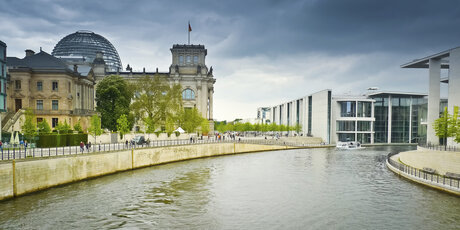





Connecting East and West
Berlin’s government buildings form a bridge over the river Spree connecting East and West. Known as the Band des Bundes – the “Federal Ribbon” – they are a fascinating mixture of modern architecture and German history.
The government buildings in the heart of Berlin form a ribbon across the river Spree, symbolically connecting East and West. The parliamentary offices and the chancellery were not built until the wall came down and Berlin was chosen as the country’s seat of government. The buildings are exciting examples of contemporary architecture that no-one sightseeing in Berlin can afford to miss.
In 1991, Germany’s parliament voted to relocate from Bonn to Berlin and return to the Reichstag. The move meant that brand-new government buildings were necessary. Except for the Reichstag and the Swiss embassy, everything else in the former government quarter by the Spree had been reduced to rubble in the second world war. This meant there was plenty of space to inspire innovative architects.
The original idea for the Band des Bundes was a gesture of reunification. In a dual piece of symbolism, the government buildings and the offices for democratically elected MPs are both a physical connection and a symbolic bridge between East and West.
They were building for democracy. Before construction began in 1995, it was preceded by the world’s biggest-ever call for projects for public buildings. 835 architects competed for the right to build Germany’s new centre of government and parliamentary offices.
The commission for the overall concept was awarded to the architects Axel Schultes and Charlotte Frank. The Paul-Löbe-Haus and Marie-Elisabeth-Lüders-Haus were designed by Stefan Braunfels. Ideas that were rejected included the originally planned square known as the Bürgerforum with cafés and shops, and the extension towards Friedrichstraße station.
The federal buildings are not just the centre of the town in geographical terms; since 2006, the striking concrete and glass buildings have been the first thing that visitors to Berlin see when they arrive at the city’s main station.
The most striking building is the Federal Chancellery, which was built between 1997 and 2001 and designed by Berlin architects Charlotte Frank and Axel Schultes in close consultation with Chancellor Helmut Kohl.
The Paul-Löbe-Haus is named after the former President of the Reichstag who later became the oldest MP in the first German Bundestag. It houses MPs’ offices, meeting rooms and the main visitors’ office. Especially striking is the glass facade on the west side. The building is connected to the Marie-Elisabeth-Lüders-Haus by a bridge over the Spree for those MPs who aren’t afraid of heights, and a tunnel under it for those who are.
Directly on the other side of the Spree from the Paul-Löbe-Haus is the German parliament’s centre for academic services. Opened in December 2003, it is named after the social reformer and women’s rights activist Marie Elisabeth Lüders. It houses the parliamentary library, which is one of the biggest in the world. Along the former route of the Berlin Wall there is publicly accessible memorial containing original segments of the wall as a reminder of the divided Germany.